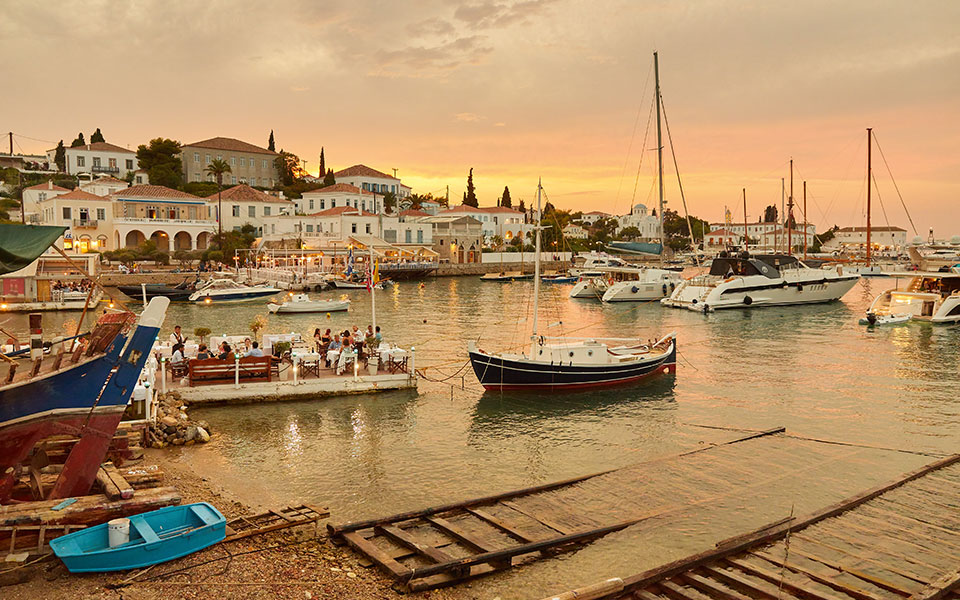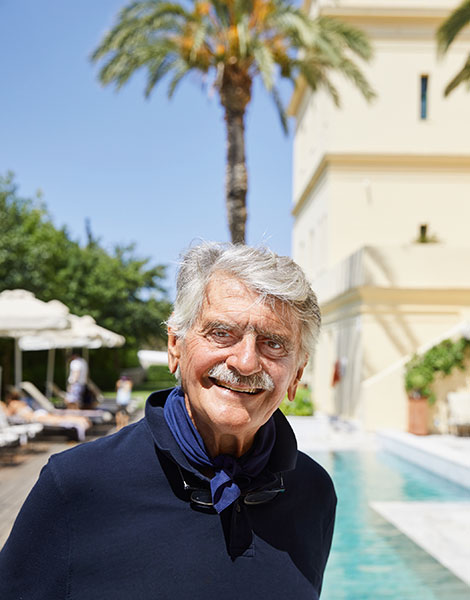A 30-year-old artist from Spetses, who studied visual arts in Amsterdam, lives in her great-grandfather’s house near Analipsi. In the summer she works at Baraka gallery, in the winter she is involved with her own artistic creations, goes fishing and takes nature walks.
Eva Vasiliou is one of the five locals who help us view the island of the Regatta and Armata through a different prism. They have all experienced Spetses during the four seasons: from the feverish tempo of the summer to the immovable quiet of the winter. All of them share a special connection to the island, because their life is composed of the basic materials Spetses is made of: the sea, the landscape, its history, the people who characterize it, and art. In brief, everyone knows the island profoundly.

© Dimitris Vlaikos

© Dimitris Vlaikos
As a high school student Eva would look out of the window half asleep, and see “the sea on the right, mountains on the left, and horses galloping.” Had she grown up in Athens and seen laundry and awnings from her school window, would she be a different artist, with another viewpoint and different artworks? Probably. “Nature plays a primary role on every island,” she says and she is right, since it was in nature that we were having this discussion, next to the olive and pine trees, among the sculptures created by the renowned Natalia Mela. Eva remembers her.
“In the summer I would come out of Aghios Nikolaos and see her lying on a small bench, with a cigarillo in her mouth and her “three-wheeler” parked behind, covered in flowers. Many times she would go swimming with her cigarillo, lying on her back.” In Eva’s memory the great Greek artist is decidedly human, not idealized, as is the subsequent image she describes regarding how the island of Spetses is changing. The island sheds its skin, according to the season, since “whatever people do in August, people do not really pay much attention to.” Yet from September 1st, the “eyes can suddenly see more,” as if automatically resetting the island’s temperature, morals and boundaries.

© Dimitris Vlaikos

© Dimitris Vlaikos

© Dimitrsi Vlaikos
Much like Eva, Grigoris Katsouranis is also a true Spetsiot. He may be carrying more Augusts on his back, but shares a similar ageless and child-like energy. Mr. Grigoris is one of the few artisans practicing the art of the “votsaloto” pebble mosaic in Spetses, a “tough job” that requires “sitting down for eight hours, putting pebbles in place.” This leads to pains in the knees, hands and lower back. Despite this physical strain, in eight hours one can create a mosaic measuring 2 square meters, often with marine themes such as boats, mermaids, fish, dolphins and octopi, as well as more unusual ones such as a belltower or a man wearing breeches and a fez hat.
These themes are generally repeated to a certain extent (“we revive the old”), something that contributes to the aesthetic harmony and limits discord. The great thing about pebble mosaics is that they serve to decorate both public and private spaces – they represent the community of Spetses as a whole, as well as the specific Spetsiot household. In his personal time, when he is not involved with making pebble mosaics or other work, Mr. Grigoris usually goes to the Kafenion for a cup of evening coffee. Not a traditional Greek one, as I expected him to say, but a freddo espresso with ice. He goes swimming with his wife in Aghia Marina, goes to Analipsi church, spends the summer at his family home in Kokkinaria, and the winter in his house in Dapia.

© Dimitris Vlaikos

© Dimitris Vlaikos
The guardian of another traditional artform, also associated with Spetses, Pandelis Korakis is a second generation boatwright who owns one of the island’s seven tarsanas (shipyards), in the Old Harbor. Pandelis has spent his entire life in Spetses, except the time when he was in the army. He began his apprenticeship at the age of 10-12 next to his father, who represented an older generation of shipwrights, who believed that this art cannot be taught, but stolen. “If you got it, you got it. That was the mindset of the time.” The shipyard came into his hands some 23 years ago. It is just a two-minute drive away from his house and his days are composed of an outdoor factory by the sea, with wood strewn left and right, with geese coming and going as he walks barefoot around, followed by a dog without a name, who follows him everywhere, even when he goes in and out of the boats. People drop by, his sister prepares the coffee, his friends show up, they have a beer, they leave.
The place seems like a coffee shop. “Many of the traditional shipyards are essentially coffee shops,” he tells me. They are also places of hard work, as Pandelis repairs and builds wooden hulls, taking advantage of the designs he inherited from his father. Among other things, he is involved with professional or amateur fishing boats and smaller caiques owned by people who vacation here. “A wooden boat is like a friend. It is not nameless, many people have worked on it.” He owns a 9-meter trehantiri sailboat, “Aghia Marina,” which he built himself a few years ago.

© Dimitris Vlaikos

© Dimitris Vlaikos
I imagine he really loves the sea, as he works next to it, for it and by it everyday. But there is another Spetsiot who I think may love it more, or in a different way. Miranda Markou is thirteen and a half years old, a student in junior high school. As a child she went swimming at Scholes beach, under the Spetses Yacht Club, and she would see the boats floating around. “I like it and decided to begin sailing.” She was not even six years old, but she was pulled in by the sea and the freedom associated with this sport. She started off with a bug, moved to an optimist and now sails a laser.
Listening to her speak about the advantages of the laser as a boat, about her desire to go to Piraeus to see the Olympiakos sailing academy and about how she has heard great things about the yacht club in Aegina, I think what a great … boost it must be for a teenager to be involved with the sea all year around and not with a computer, how much character and confidence learning how to manage a boat must build. Mostly, I think about how great it must be to be thirteen years old, living on a small Greek island, within the town but not in Dapia, and how it must feel to be moving around, for school, to meet friends, or go to your sailing club, using an electric scooter, your parent’s moped or even by foot.

© Dimitris Vlaikos

© Dimitris Vlaikos
However, Spetses is also associated with another captain, older and greater, a woman who surpassed the limitations society placed on her gender, since she became “the first female admiral in world naval history,” as Pavlos Demertzis-Bouboulis tells us about Laskarina Bouboulina, the great-grandmother of his great-grandfather. Pavlos is 33 years old, a modern man without a fustanella or tsarouchia shoes, but who carries a heavy name, long but also familiar. A name that would have been lost to his family had his grandfather, Christos Demertzis, not intervened – he was married to Euphrosene Boubouli, and “submitted a formal request to the Ministry of Interior to add the name Bouboulis to his son’s name, my father’s name, so that it does not get lost. And so we carry both surnames, Demertzis-Bouboulis.”
What is it like to grow up on the island of Bouboulina with this name? “When I was a child, it was not that easy. First, we grew up with a museum above us. They hunted me down at school to participate in every theater production, to recite every poem. It was as I got older that I realized what Bouboulina actually means for people and what my responsibility is towards my name and its heritage.” Pavlos, with his mother and siblings, is manager at the Bouboulina Museum, housed in the female captain’s former mansion. He spends summers on the island, and winters between Spetses and Athens. “September and October are beautiful months here. In the winter, it is just us and the cats, which has a certain beauty of course, and the island still smells of pine and thyme.” Regarding the museum, it is closed during the winter months. Bouboulina is sleeping. Until the next summer when the island slowly awakens, she will also rise from her slumber, and come to life once more through the tales narrated by her descendants.

© Dimitris Vlaikos

© Dimitris Vlaikos
Poseidonion, a destination hotel
In its history, Spetses was marked by two people. The first is undoubtedly Bouboulina. The second is Sotirios Anargyros (1849 – 1928), a Spetsiot migrant who made an enormous fortune abroad. His history and his relationship with the island cannot be discussed here, it would require an entire book. Among many other things, Anargyros created the Anargyreos & Korgialenios School of Spetses, in operation until the 1980s, he reforested Spetses after its deforestation due to logging and agriculture, he envisioned and built the Poseidonion, one of the most beautiful hotels in Greece that celebrated its 100-year anniversary in 2014. Since 2009 it has been renovated and operated by the Vordonis family.
As Mr. Manolis Vordonis mentions, Anargyros protected it by ensuring that the A.K.S.S. Foundation could not sell it or change its use. During the planning stages, Anargyros and the architect traveled to the South of France, absorbed images of the resorts of the French Riviera and brought them back to Spetses. Looking at it today, restored based on the original model, one is almost in awe of this landmark’s bizarre beauty, something so foreign yet so inherently representative of Spetses. Painted in light colored tones, with turrets and columns, the Poseidonion combines a variety of artistic influences and movements. It stands out from the luxury resorts of the present day in that nothing is built to excess. The entrance, the lounge, the garden, the swimming pool, are all built to the size of man and this makes visitors feel at ease. Traversing the doors of the Poseidonion, it feels as if someone is already expecting you inside.












